By Frank Lansner
I came across Hans Errens illustration showing the yearly growth in CO2 concentration as a function of UAH global temperatures:
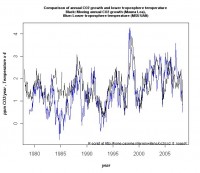
See larger image here.
It appears from this graph that CO2 concentrations follows temperature with a lag of approximately 6-9 months. The interesting part is of course that the CO2 trends so markedly responds to temperature changes. I wanted to get a clearer picture of this relationship, and thus took approximately 20 datasets from this graph And plotted them in a scatter graph to see the trend, and got the following result:

See larger image here.
The equation is built on data in the big range from CO2 growth 0.5 to 3.5 ppm/year, and all fits fine the very same trend. So in real world today we have a CO2-growth as a function of temperature approximately: CO2 growth (ppm/year) = 2.9 temp.anomaly(K) + 0.7 . And we see that if UAH temperature anomaly should reach - 0.3 K, CO2 growth should stop.
What are the consequences?
1) The quick response up and down for CO2 trend shortly after temperature changes suggests that we see a “dance” around equilibrium conditions in nature.
2) The equation confirms that despite human or other contributions to CO2, the CO2 trend is very sensitive to temperature. This is a fact. For example if temperature rises 0.5 degrees and this trend holds for around 30 years, we should see a trend of approx 1.5 ppm CO2/year, over 30 years adding up to a net CO2 build up of 45 ppm.
Is it realistic then, that CO2 concentration should have been constant within a 15 ppm band for almost 1000 years? This would require extremely constant temperatures. Even temperatures from IPCC AR4 could not fulfil such invariability it would take to keep CO2 almost unchanged. Read more here
See the detailed Dr. Jeffrey Glassman paper The Acquittal of Carbon Dioxide that found the same thing in the ice core data here.
By Joseph D’Aleo, CCM, AMS Fellow
One of our loyal Canadian Icecap readers asked us to comment on the fact we are now at the end of November, in the top five years with the most sunspotless days the last century (ranking #3) perhaps even heading topwards a #2 finish depending on how many spotless days we have in December. Here is a comparison of monthly spotless days in this cycle 23 minimum (red) versus the last cycle 22 minimum in the mid 1990s (blue).

See larger image here
Notice how quiet and prolonged this minimum has been compared to the last minimum. As of today, December 8, we have had 246 spotless days in 2008, enough to put us in 3rd place ahead of 1954. Today will extend the latest string of sunspotless days to 21, 8 this month. If we match November’s 16 spotless days in December, we will be in a virtual tie for second place with 1912 (with 253 spotless days) behind just 1913 which had 311 spotless days (data source SIDC).
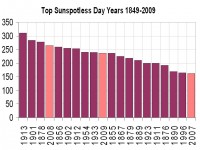
See larger image here
Notice how 2007 and 2008 are both in the top 10.
So far in the solar minimum after cycle 23, we have had 489 spotless days, the most since cycles 14-16, in the early 1900s. Note in cycle 14, three years came in the top 10 for spotless days, 1911, 1912, 1913. This is the second year in this cycle in the top 10. 1912 was the second high spotless year after cycle 14.
QUIET SOLAR PERIODS ARE COLD PERIODS
Case in point the Maunder Minimum during the little ice age, virtually spotless for decades/centuries from the late 1400s to early 1700s. The early 1800 quiet sun period known as the Dalton Minimum was a mini ice age. Cold returned in the late 1800s and early 1900s with again a declining sun.
See this story in the Toronto Star by Adam Mayers from February 2007. It talks about 1911/12 winter, the worst winter of the century for that city.
“It may seem cold this week, but it is nothing, nothing, compared with the winter of 1912, a year that remains in the record books as the worst winter of the past 100 years. By mid-January, it was so cold Toronto harbour was frozen solid. By early February, the near-shore lake ice was a metre thick, and you could skate from Toronto to Hamilton if you had the time. By the middle of the month, everyone was taking bets on whether the lake was frozen over. By month-end, it was. It was the rumour that the lake ice was finally solid from Toronto to Rochester that brought a huge crowd to Sunnyside Park on the afternoon of Feb. 11, 1912. They wanted to witness what the Star called a once-in-a-lifetime experience, “a spectacle they had never seen before and may never witness again.”

Read more here (UPDATED). See David Archibald’s post on Warwick Hughes site on the evidence for and implications of another Dalton Minimum.
Shaping Economic Analysis to Suit Climate PoliticsBy Roger Pielke Jr., Prometheus
Today’s ClimateWire reports that California’s proposed climate policy - known by its bill number as AB32 - has been soundly criticized by a distinguished panel of six internationally recognized economists with expertise in carbon policies: California intentionally skewed its analysis of the economic effects of its climate change plan, according to a review by state-commissioned economists.
All six economists found the analysis deeply flawed, and several even said the state hand-picked data to improve the economic case for reducing greenhouse gas emissions. Wow. When policy makers and experts shape an analysis to suit a political agenda some people have been known to throw around terms like a “war on science”. Somehow I doubt that we’ll hear any concerns about a “war on economics” being waged by the state of California. More seriously, what is going on here is that advocates for certain policies face temptations to present those policies in the best possible light in order to increase the chances that the proposed actions will be adopted. As we’ve argued here for a long time, such biased analyses can be found across issues and the political spectrum, even in the case of California’s carbon policy.
The fact that California’s AB32 has failed peer review does not mean that it is necessarily a bad idea, it just means that policy makers and Californians really have no idea what the effects of the proposed policy will actually be when implemented. The consensus of the peer reviewers is that the costs of the proposed policy are likely to be much higher than the stateís economic analysis suggests, and there are far more uncertainties than the analysis considers.
Disappointingly, but not surprisingly, the state of California largely brushes off the peer review comments with the following rather amazing dismissal: Economic modeling is not an exact science, and there will always be different opinions about assumptions and how to apply the available tools. This is to be expected. So if economic modeling is really about opinions, of which there are many, then why in the world submit any such analysis for peer review?
Attached are a few excerpts from the peer review submissions, which include some very strong criticisms. The peer review report can be found here in this PDF. Read Roger’s full post and comments here.
By Joseph D’Aleo, Icecap
SECOND ANNUAL INTERNATIONAL CONFERENCE ON CLIMATE CHANGE
I am writing you today is to alert you to the Second Annual International Conference on Climate Change in New York City on March 8-10, 2009 sponsored primarily by the Heartland Institute. The theme of the conference is “Global Warming Crisis: Cancelled. Was it ever really a crisis?”
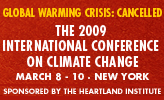
Last year after the first conference was announced, alarmists socffed that no one would show up and that you could fit all the remaining skeptics in a phone booth. Well over 500 attended (some big phone booth). Over 100 scientists, economists, government policy experts, politicans, energy experts, and even some media representatives presented papers and talks. They came from all corners of the globe and including a moving talk by a head of state - Czech Republic’s Vaclac Klaus. Even Andy Revkin of the NY Times was impressed by the turnout.
This year’s conference promises to be bigger and even better. For the second to 1000 attendees are expected. There will be well over 70 speakers including Dr William Gray, Dr. Richard Lindzen, Dr. Roy Spencer, Dr. Willie Soon, Dr. Bob Carter, Dr. Fred Singer, Anthony Watts, Steve McIntyre, Dr. Ross McKitrick. William Cotton, Joe Bast, Lord Christopher Monckton, Craig Idso, Dr. Benny Peiser, David Douglass, Davis Legates, Lawrence Solomon, Syun Akasofu, Marlo Lewis, John H. Sununu, John Coleman, Chris Horner, Dr. Tim Patterson, Dr. Paul Reiter, James M. Taylor and many, many more. I am fortunate to also be speaking. One or more major surprises are also possible.
The on-site registration fee will be $720 at the door (there is a 20% discount if you signed the Petition Project and an early bird rate - both requiring you to see the Heartland registration on-line site). You would have to arrange and pay for your own travel and lodging. Rooms at the conference hotel are available.
SPECIAL FOR ICECAP DONORS
Icecap is one of the co-sponsors. We as a co-sponsor, will have tickets available that will cover the registration fee. If you make a donation to Icecap, and notify me at this email (jsdaleo6331@aol.com) that you plan to attend, you name will be put in a hat along with the 6 largest donors from the last year and I will draw a dozen winners who will receive free admission. If you win, you can pick up your ticket at the registration desk. Please inform us if you decide you can’t make it, so we can make the ticket available to others who can.
This is a real opportunity to meet and talk to some of the giants in the field. I attended and spoke at last years’ conference which I wrote about here. See the audio, video and powerpoints from the 2008 presenters here. Read Vaclav Klaius’s address here.
This conference has never been more important than it is now when our federal and state and even local governments have taken or are contemplating unnecessary and unwise steps that will do further harm to an already collapsing global economy. This even as the global cooling continues now in into its 7th year. Help us spread the truth.
By Craig Idso, CO2 Science
In his testimony before the U.S. House of Representatives’ Select Committee on Energy Independence and Global Warming, NASA’s James Hansen stated “there is increasing realization that sea level rise this century may be measured in meters if we follow business-as-usual fossil fuel emissions.” Agreeing with Hansen, many people have been quick to jump on the CO2-induced global warming/rising sea level bandwagon. But how close to reality are the projections of a future sea level rise that is measured in meters?
For larger video go here.
More Truth alerts can be found here. See the CO2 Science site with its extensive library and the Medieval Warm Period project here. They also have 5 excellent DVDs on the so called Climate Crisis. The latest of which is shown below. They are available from the site.
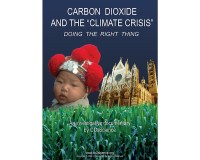
By Viscount Monckton of Brenchley on the American Thinker
In a video shown at a costly, two-day “global warming” jamboree at the Beverly Hills Hotel, hosted by Governor Schwarzenegger of California in November 2008, Barack Obama said: “Few challenges facing America and the world are more urgent than combating climate change. The science is beyond dispute and the facts are clear. Sea levels are rising. Coastlines are shrinking. We’ve seen record drought, spreading famine, and storms that are growing stronger with each passing hurricane season. Climate change and our dependence on foreign oil, if left unaddressed, will continue to weaken our economy and threaten our national security.”
Obama said he would introduce “a federal cap and trade system to reduce America’s emissions of carbon dioxide to their 1990 levels by 2020 and reduce them an additional 80 percent by 2050.” He said his administration would “invest” $15 billion a year in solar power, wind power, biofuels, nuclear power and clean coal to “save the planet” by creating 5 million new “green jobs”.
Few challenges facing America and the world are less urgent than combating the non-problem of “global warming”. On all measures, there has been no increase in global mean surface temperatures since 1995; and, according to the University of Alabama at Huntsville, near-surface temperatures in 2008 will be lower than in 1980, 28 years ago, the first complete year of satellite observations. On all measures, global temperatures have been falling for seven full years since late 2001. The January-to-January fall in temperatures between 2007 and 2008 was the greatest since global temperature records were first compiled in 1880, 128 years ago. The rate of new Arctic sea-ice formation in mid-October 2008 was among the fastest since satellite records began almost 30 years ago. There has been no decline whatsoever in the total global extent of sea ice since satellite records began. New records for the extent of northern-hemisphere snow cover were observed by the satellites in the winter of 2001 and again in 2007. This year, many ski resorts are opening early as Arctic weather strikes. Many temperature stations in the northern hemisphere recorded record low temperatures in October/November 2008.
These facts are inconsistent with the notion that “global warming” is occurring, still less that it is dangerous. The Sun continues to show very few sunspots. Many solar physicists now predict at least half a century of global cooling, which would be a far greater and more destructive problem than a little warming.
Obama is not correct to say, “The science is not in dispute.” Across all disciplines, some 31,000 scientists approached by the Oregon Institute of Science and Medicine in 2007/8 signed a declaration to the effect that “global warming” is not a global crisis and that humankind has very little influence over the climate. A survey of climatologists and scientists in related fields by Van Storch (2005/6) established that a considerable proportion of respondents did not believe the alarmist notions disseminated by Al Gore or the UN climate-change panel. The office of Senator James Inhofe maintains a list of more than 500 scientists in climate and related fields who have made public statements questioning at least one aspect of what has falsely been presented as a scientific “consensus”. Read more here.
By Erika Lovley, Politico.com
Climate change skeptics on Capitol Hill are quietly watching a growing accumulation of global cooling science and other findings that could signal that the science behind global warming may still be too shaky to warrant cap-and-trade legislation. While the new Obama administration promises aggressive, forward-thinking environmental policies, Weather Channel co-founder Joseph D’Aleo and other scientists are organizing lobbying efforts to take aim at the cap-and-trade bill that Democrats plan to unveil in January.
So far, members of Congress have not been keen to publicly back the global cooling theory. But both senators from Oklahoma, Republicans Tom Coburn and Jim Inhofe, have often expressed doubts about how much of a role man-made emissions play. “We want the debate to be about science, not fear and hypocrisy. We hope next year’s wave of new politics means a return to science,” said Coburn aide John Hart. “Itís the old kind of politics that doesnít consider any dissenting opinions.”
The global cooling lobby’s challenge is enormous. Next year could be the unfriendliest yet for climate skeptics. Already, House Energy and Commerce Chairman John Dingell (D-Mich.) has lost his gavel, in part because his peers felt he was less than serious about tackling global warming.
The National Academy of Sciences and most major scientific bodies agree that global warming is caused by man-made carbon emissions. But a small, growing number of scientists, including D’Aleo, are questioning how quickly the warming is happening and whether humans are actually the leading cause.
Armed with statistics from the Goddard Institute for Space Studies and the National Oceanic and Atmospheric Administrationís National Climate Data Center, D’Aleo reported in the 2009 Old Farmer’s Almanac that the U.S. annual mean temperature has fluctuated for decades and has only risen 0.21 degrees since 1930 - which he says is caused by fluctuating solar activity levels and ocean temperatures, not carbon emissions.
Data from the same source shows that during five of the past seven decades, including this one, average U.S. temperatures have gone down. And the almanac predicted that the next year will see a period of cooling. “We’re worried that people are too focused on carbon dioxide as the culprit,” D’Aleo said. “Recent warming has stopped since 1998, and we want to stop draconian measures that will hurt already spiraling downward economics. We’re environmentalists and conversationalist at heart, but we don’t think that carbon is responsible for hurricanes.”
D’Aleo’s organization, the International Climate and Environmental Change Assessment Project, is collaborating on the campaign with the Cooler Heads Coalition, a subgroup of the National Consumer Coalition with members including Americans for Tax Reform, the National Center for Policy Analysis and Citizens for a Sound Economy. More than 31,000 scientists across the world have signed the Global Warming Petition Project, a declaration started by a group of American scientists that states man’s impact on climate change can’t be reasonably proven. Read more on it here.
See also this Politico piece on the so called “Gore Effect” here. See Lubos Motl comment on the Gore Effect here. Please write the author (elovley@politico.com) and thank her for two very fair and balanced pieces on climate change. You can be sure she will hear from the alarmists. Update: Dave Roberts and Joe Romm kings of scientific malpractice over at the alarmist blog Grist attacked Politico as expected. Dave Roberts of Grist has advocated Nuremberg- style trials for skeptics of warming (2006). Romm - who served under Gore as Acting Assistant Secretary of the U.S. Department of Energy in 1997 and as Principal Deputy Assistant Secretary from 1995 though 1998 - authored a piece amazingly entitled “Did Climate Change Contribute To The Minneapolis Bridge Collapse?
The dismantling of The Weather Channel Environmental team is as much a public relations statement as it is a material policy shift exacted by General Electric. The timing of this action should be alarming to The American Meteorological Society, academia and other institutions funded by thinly disguised grant money gravy train.
Paul Farrell, a columnist with CBS marketwatch makes a strong case that the current economic peril that the United States is in, is the result of a concept that he calls “destruction capitalism”. Basically he states that since the 1980s, a series of economic bubbles were created by the peddling of the illusion of external threats. The y2k myth is a classic example of a miscalcution, intentional or otherwise that led to the federal reserve pumping massive liquidity into the general economy. much channeled into the .com craze that led to the worst stock market crash and national recession since the early 90s. The oil bubble is another example, with pronouncements by Goldman Sachs and other institutions that the price per barrel of oil would soon eclipse $200.00 a barrel. The housing bubble and sub prime mess are other examples, paradoxiacally, are examples of failures that were misrepresented in an opposite manner, until it was too late for the unwitting.
Last year, Farrell predicted that the final attempt to create a false industry would be created by the fear peddled to the public by the perils of global warming. He also stated that the attempt would fail for two reasons. First, the general public is not buying into the myth. Surveys taken before the general election showed that global warming scored far down the list of electorate concerns. In fact, a large majority of the democratic base indicated an unwillingly to pay any additional money from strained family budgets for greehouse gas curbs.
Thus, the symbolic and practical nature of GE’s action is telling. The timing of the action may have been coincidental relative to market declines and considering that they happened in the middle of Green Week on GE-owned NBC. More likely it represented a small measure of hope, that the free market system actually does work, despite years of cynical rigging by Al Gore, university meteorology departments, The Weather Channel and most importantly, The American Meteorological Society.
GE likely dismisses those interests as pawns in a failed coupe on the sensibilities of the populace and shareholders. By the public execution of the environmental unit GE was tacitly communicating to worldwide investors that they “Get It”. It is also notable that during the same week that this action occured, The French Company responsible for constructing GE wind turbines, business model failed and to the degree that GE was enmeshed in financing the operation, they failed as well. The economies of scale for General Electric are vast and if their attempt to satisfy the demands of an already questionable market failed, common sense would indicate that all other venture capital earmarked for alternative energy would be second guessed. In the public sector, any policy that would overtly impact Americans finances during this time would be, at best perilous.
They will be forced to share diminishing resources, have difficulty maintaining gainful employment and repairing the damage exacted on their credibility. The healthiest directive that the AMS can employ would be to craft a policy statement, acknowledging the true nature of climate change, it’s complexities and the limits of our understanding the vast complexities of the world around us. Ironically, it will require those of us who, despite being sanctioned by the AMS, news management and some state governments and aligned newspapers who would be best suited to “carry a torch” to resurrect the reputation of the AMS, government and news departments who are even now damaged by the disinformation campaign that has gone on, irrelevantly and nearly tragically far too long. So too, one can only imagine what is going on in the psyche’s of educated men and women who became seduced by the blood lust of mob rule.
The cognitive dissonance and self delusion will be unmasked by a sudden material insecurity before family, community and academic circles. Despite a false front it will in actuality will be internally devasating and isolating. Conversely, men and women of character will regard those with a regard for the truth with dignity and respect. It would seem that the choice is really quite simple.
Explosive Development in East Coast CyclonesBy Joseph D’Aleo, CCM, Fellow AMS
With some of the coldest weather since 2000 or even 1989 coming to the United States, Western Europe and Eastern Asia for December, I thought this story I did for Intellicast.com might be of interest to those with a weather interest.
East coast cyclones in winter can produce prodigious snowfalls burying the major cities of the east. They come in different flavors - as waves along fronts offshore or as storms that develop secondary to inland lows.
My Masters Thesis at the University of Wisconsin was on Explosive Development in East Coast Cyclones. In that study I found the most common precursor was a cold outbreak into the Atlantic ahead of the trough and storm development. This generates a considerable reservoir of available potential energy that gets released when the upper conditions become more favorable. You can see visible signs of this with the clouds that form in the cold air stream off the coast over the warmer water.
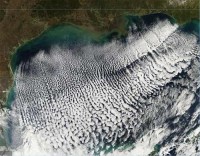
This vertical development is limited by subsidence in the negative vorticity advection (NVA) area ahead of the short-wave ridge between systems.
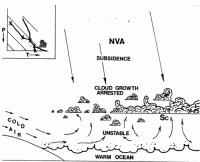
This produces an inversion that acts as a lid on vertical motion. After the passage of the short wave ridge and the start of positive vorticity advection, the lid is removed and penetrative convection begins. Often this takes the form of thunderstorms which transfer sensible and latent heat into the storm and help pressures fall rapidly. Pressure falls of up to 40mb in 24 hours have been recorded.
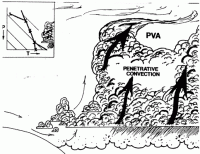
The dynamics of the upper systems of course play a role in how much development occurs. Kocin and Uccellini in their wonderful two volume monograph available from the AMS discussed the schematics of the jet stream circulation in many or most east coast cyclones.
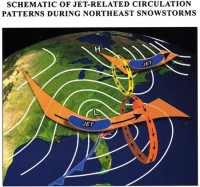
In my thesis, one of my case studies was the storm of March, 1960, shown in the linked story. Note the preceding cold air mass flooding cold air offshore. Note the approaching surface low reflecting the approaching trough and southern jet. Note how the coastal low quickly takes over the circulation as it explosively deepens on March 3rd. See more including the maps for that storm here.
DotEarthAction blog interview from KVMR, Nevada City, California
KVMR: Through a video link, President-elect Barack Obama addressed a climate change conference convened today by Arnold Schwarzenegger in Los Angeles, saying he would more aggressively tackle the problem of climate change than the Bush Administration. But behind the politics of global warming, scientists are engaged in a robust debate about the effects of manmade CO2 in our atmosphere. Joining us now is a researcher involved in the debate over climate change.
Robert Balling Jr is a professor in the climatology program of the School of Geographical Sciences at Arizona State University. He has served as a climate consultant to the United Nations Environment Programme and served on the Intergovernmental Panel on Climate Change; Robert, welcome to the KVMR evening news. I want to start by asking - “Can you maybe describe the debate thatís going on among scientists and in peer reviewed journals and otherwise, over the issue of climate change?”
RCB: “Well I’ll do that, just as soon as you tell me what happened in the Civil War. It’s kind of a big question - if you were to go to a library or look at any top of the line science journal, you would quickly discover that every element of the greenhouse issue has its folks who seem to be supportive of certain ideas, and others who are not. The most fundamental questions, like, is the planet warming - in reality there’s quite a debate about that very subject; as I tell people, you would just discover that the climate change issue is very much more complicated than it is often presented to the public. And that’s somewhat the message I have on the circuit, is that no matter what thing you ask about, you find out there’s an incredible story behind it and quite a debate going on in the scientific community.”
KVMR: “Well, let’s just step back and tackle that question - “is the planet warming, and how do we know?” To me it’s scientists collecting data and then drawing conclusions based on that data, right? well, is the planet warming?”
RCB: “Yes and no. We have a there are a number of ways that the planetary temperature is taken - there are satellites that measure microwave emissions that come from the low atmosphere (those are directly related to the temperature of the low atmosphere, these polar orbiting satellites that allow for a global temperature to be measured); balloons are launched all over the world every day, the balloon record can give us a sense of the planetary temperature; and then there are literally millions of thermometer records from all over the world, and they’re not perfect by any means but they can all be averaged and get another sense of the planetary temperature; the good news is theyíre all very highly correlated. So it would seem easy, is the earth warming or not? If you said how about the last 30 years, the answer’s absolutely, all three of those primary ways that we measure the temperature of the earth show warming. But if you said how about for the last 7 years from 2002 to present, all three show cooling.
So you could answer the question a thousand different ways - if you said is the earth warming and you mean the last 100 years, the answer’s yes; if you mean the last 1000 years the answer may not be yes, or if you mean how about the last million years, the answer is well, we’ve actually been rather cold the last million years. So that question is not as easy to answer as it sounds at first glance. Read much more here.
By Matthew Knight, CNN
A team of international scientists led by Dr James Hansen, director of NASA’s Goddard Institute for Space Studies, say that carbon dioxide (CO2) levels are already in the danger zone. Concentrations of CO2 in the atmosphere currently stand at 385 parts per million (ppm) and are rising at a rate of two ppm per year. This is enough, say the scientists, to encourage dangerous changes to the Earth’s climate.
As a result we risk expanding desertification, food shortages, increased storm intensities, loss of coral reefs and the disappearance of mountain glaciers that supply water to hundreds of millions of people. The Aletsch glacier in the Alps. Melting of mountain glaciers is accelerating worldwide.
The report, “Target Atmospheric CO2: Where Should Humanity Aim?” appears in the latest edition of the Open Atmosphere Science Journal and brings together the expertise of ten scientists from the United States, the UK and France. It is a departure from the previous climate estimates which predict that perilous CO2 levels will be reached later in the century. Drawing on improved paleoclimate records and current global observations has prompted the authors to reach new conclusions about what constitutes a safe level of CO2.
Dr Hansen told CNN: “In the paleoclimate data, the Cenozoic data is the most alarming—burning all the fossil fuels clearly would send the planet back to the ice-free state with sea level about 250 feet higher.” Hansen thinks these sorts of changes would take several centuries, but he said we would have to deal with a “holy mess...as ice sheet disintegration unfolded out of our control”.
In light of the new data the authors believe that merely stabilizing CO2 emissions might not be enough to avoid catastrophic changes. “Humanity must aim for an even lower level of greenhouse gases”, the report concludes. To achieve these reductions they propose phasing out coal-fired power stations by 2030 and scaling down the use of unconventional fossil fuels like tar sands. Reforestation programs on degraded land and instigating the widespread use of natural fertilizers could also help to draw down CO2 by around 50 ppm. Dr Hansen says it’s impossible to say when we will reach the point of no return. See story here.
Icecap Reality Check: In actual fact, the change in CO2 is natural and due primarily to warming oceans. As Dr. Segalstad has said you could burn all the fossil fuels on the planet and the CO2 would not rise more than 20% more due to the fact the oceans are an infinite buffer. The enhanced CO2 has allowed for a greening of the middle latitude, more reliable precipitation (from the hydrological cycle) and more drought resistant plants and crops and the ability to feed more of the world’s population. In greenhouses, they pump in CO2 to 1000 ppm or higher to get more growth. Most all of the warming in the 1980s and 1990s was at night and in the winter in higher latitudes, which has been welcomed.

See larger NASA image here
Since 1998, temperatures stopped rising and since 2002 have been falling. It appears the only point of no return is Hansen objectivity.
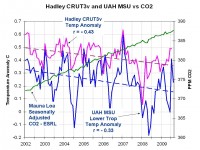
See larger image here
By Meteorologist Art Horn
Well here we go again. NBC (read General Electric) has just completed another “green week” on the Today show and every other channel that is part of the NBC Universal chain. They even had to drum beat the “Oh the world is ending because humans cause global warming” on their Sunday night football half time show. Having worked for NBC for 20 years I can just imagine being in the booth with Al Michaels and John Madden as they roll their collective eyes at having to plug this whole green thing during a football game. I can see Madden saying “Yea, green like the green on the field, looks fine to me, boom! Let’s get back to football, this is a football game right?” But remember General Electric is pushing green big time.
They make all kinds of products that they hope will sell in a greener economy like wind turbines. Now that’s ok, nothing wrong with making some money but whole thing is just so phony. Just look at what’s happening at the Weather Channel. NBC Universal recently bought the Weather Channel and now the winds of change are blowing hard north of Atlanta. Up to 80 people are being let go with the biggest casualty being the dreadful Forecast Earth program with Dr. Heidi Cullen. This program was one of the best examples of global warming fear mongering ever. It now finds its final resting place where it belongs, out in the cold!
I find it interesting that during the same week that NBC Universal goes green they shut down the most obvious green show they own. This proves that the message of “going green” is not what it appears to be. It’s about moving product and profit. The ratings for Forecast Earth were in the tank so as always happens in television it gets the hook if the ratings are not up to expectations. There is nothing wrong with this, its business. Television programs must have audience to make money. But this move highlights the fact that “going green” is not about the environment or concern for global warming consequences, it’s about money.
There will be another green week I hear sometime down the road. With green stocks crashing and concern about the economy and the real world overtaking the global warming fantasy GE will be pushing harder than ever to “go green” It’s just not the same green that’s being pushed on the air. Being an employee at NBC Universal must be very trying if you’re not a global warming soldier. But the orders are clear, go green and get eyeballs or else. Read more here.
By Ellen Gilbert
Freeman Dyson gets around. Last Wednesday, for example, the 85-year-old “retired” physicist regaled a lunchtime audience at the Nassau Club with his “heretical” ideas about global warming. Just a few hours later he could be found once again sharing his thoughts on global warming, as well as on intelligent design, nuclear warfare, extraterrestrial life, and HAR-1 (a DNA component that distinguishes human beings from other animals) with a standing-room-only crowd at Labyrinth Books.
Mr. Dyson’s credentials are venerable: the British-born scholar received a BA from the University of Cambridge in 1945, and was, from 1953 until his retirement in 1994, a physics professor at the Institute for Advanced Study. The absence of a PhD in his resume has been more than compensated for by the 21 honorary degrees he has received over the years.
He seems happiest, however, when he is working at being the rebel, and indeed, one of his books, a compilation of essays published earlier in The New York Review of Books, is called The Scientist as Rebel. Wearing an effusively-colored tie that set off his g ray suit, Mr. Dyson began his talk at the Nassau Club by encouraging the audience to interrupt him as he spoke, since, he declared, “it’s much more fun to have an argument than do a monologue.”
In the absence of audience interruptions, Mr. Dyson had an argument anyway with the scores of people (like Al Gore) who weren’t present to defend their belief in the dire consequences of global warming. ("There’s no accounting for human folly,” Mr. Dyson said when asked about Mr. Goreís Nobel Prize.) Saying that on a recent trip he and his wife found Greenlanders to be delighted with their warmer climate and increased tourism, Mr. Dyson suggested that representing “local warming by a global average is misleading.”
In his comments at both the Nassau Club and Labyrinth, he decried the use of computer modeling to make “tremendously dogmatic” predictions about worldwide trends, without acknowledging the “messy, muddy real world” and the non-climatic effects of increased carbon dioxide. “There is no substitute for widely-conducted field operations over a long time,” he told the Nassau Club audience, citing the “enormous gaps in knowledge and sparseness of observation” that characterize the work of global warming experts.
Mr. Dyson’s fearless commentary continued later at Labyrinth, where, standing for over an hour and without a microphone, he delighted a full house by decla ring the existence of 10,000 string theorists to be “sociologically dangerous” ("one thousand would be enough"), and balked at an audience member’s query about what he would do with a $700 billion grant. “When science gets rich it becomes political,” he observed. As an example of the most expensive efforts not necessarily being the most worthwhile, he pointed to CERN’s Large Hadron Collider in Geneva, the subject of much recent attention, noting that it was designed to identify only certain particles, losing much potentially interesting information in the process. “The important things are the ones you don’t expect,” he noted.
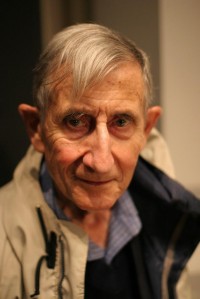
By Anthony Watts, Watts Up With That
Sometimes, words fail me in describing the absolute disregard of the placement of NOAA official climate monitoring sites. For example, this one in Clarinda, Iowa submitted by surfacestations volunteer Eric Gamberg:
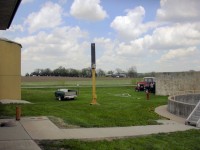
The MMTS temperature sensor is the short pole next to the half pickup truck.
For those of you that don’t know, this station is located at the wastewater treatment plant there. I’ve written many times about the placement of stations at WWTP’s being a bad idea due to the localized heat bubble that is created due to all the effluent coming though. The effect is especially noticeable in winter. Often you’ll see steam/water vapor in the air around these sites in winter, and more than one COOP observer has told our volunteers that snow sometimes does not stick to the ground at WWTP’s.
The larger pole appears to be a gas burnoff torch for excess methane. I can’t say how often it is activated (note the automatic ignitor circuit on the pole) but I can tell you that putting an official NOAA climate thermometer within a few feet of such a device is one of the worst examples of thoughtless station placement on the part of NOAA Iíve ever seen. Here is an example of a methane burn-off device at another WWTP.
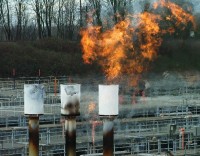
We’ll probably never know what the true temperature is in Clarinda because untangling a measurements mess like this is next to impossible. How many days was Tmin and/or Tmax affected at this location by gas burnoff and to what magnitude? We shouldnít have to ask these questions. And, adding insult to stupidity, the GISTEMP Homogenization adjustment makes the trend go positive, especially in recent years. (see automated animation of the before and after here).
Dr. Hansen and Mr. Karl - welcome, feast your eyes on the source of your data. You might want to think about changing this description on the NCDC website for USHCN: “The United States Historical Climatology Network (USHCN) is a high quality, moderate-sized data set of daily and monthly records of basic meteorological variables from over 1000 observing stations across the 48 contiguous United States.”
I suggest to NCDC that “high quality” doesn’t really apply in the description anymore. See full post and comments here.
Alaskan Glaciers Grow for First Time in 250 Years
By Michael Asher, Daily Tech
A bitterly cold Alaskan summer has had surprising results. For the first time in the area’s recorded history, area glaciers have begun to expand, rather than shrink. Summer temperatures, which were some 3 degrees below average, allowed record levels of winter snow to remain much longer, leading to the increase in glacial mass.
“In mid-June, I was surprised to see snow still at sea level in Prince William Sound”, said glaciologist Bruce Molnia. “In general, the weather this summer was the worst I have seen in at least 20 years”. “On the Juneau Icefield, there was still 20 feet of new snow on the surface [in] late July. At Bering Glacier, a landslide I am studying [did] not become snow free until early August.”
Molnia, who works for the US Geological Survey, said it’s been a “long time” since area glaciers have seen a positive mass balance—an increase in the total amount of ice they contain. Since 1946, the USGS has maintained a research project measuring the state of Alaskan glaciers. This year saw records broken for most snow buildup. It was also the first time since any records began being that the glaciers did not shrink during the summer months.
Those records date from the mid 1700s, when the region was first visited by Russian explorers. Molnia estimates that Alaskan glaciers have lost about 15% of their total area since that time—an area the size of Connecticut. One of the largest areas of shrinkage has been at the national park of Glacier Bay. When Alexei Ilich Chirikof first arrived in 1741, the bay didn’t exist at all—only a solid wall of ice. From that time until the early 1900s, the ice retreated some 50 miles, to form the bay and surrounding area.
Accordingly to Molnia, a difference of just 3 or 4 degrees is enough to shift the mass balance of glaciers from rapid shrinkage to rapid growth. From the 1600s to the 1900s, thatís just the amount of warming that was seen, as the planet exited the Little Ice Age.
Molnia says one cold summer doesn’t mean the start of a new climatic trend. At least years like this, however, might mark the beginning of another Little Ice Age. As DailyTech reported earlier, Arctic sea ice this year has also increased substantially from its low in 2007. Read more.
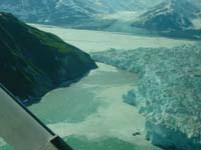
Alaska is cooling due to the cooling Pacific (negative PDO) and likely low solar activity which produced a cold and snowy winter and spring and cloudy cold summer. This is the inverse of the step warming that took place in 1979 when the PDO went positive andf the sun neared the Grand Maximum.




